|
|
|
 |
|
| Medieval Sword of Robert the Bruce (501495) |
Points: 10

|
Medieval Sword of Robert the Bruce. Inspired by the King of the Scots, Robert the Bruce, this sword has the Cross of St. Andrew set in the pommel. Hand forged 1065 high carbon steel comprises the blade. Overall: 43-1/2″ this sword dates circa 1300 and is made as seen in the film Robert the Bruce!
|
|
|
|
|
|
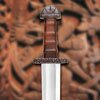 |
|
| Ashdown Viking sword (501561) |
Points: 10

|
Ashdown Viking sword. The cross guard is richly decorated with raised knots. Both the guard and the head are made of steel and have been darkened to give an antique finish. Soft leather covers the wooden handle. The set includes a leather scabbard with a matching belt, which has a very decorative metal fitting.
|
|
|
|
|
|
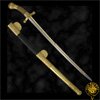 |
|
| Hanwei Charlemagne Saber (SH2288) |
Points: 30

|
The "Saber of Charlemagne the Great" is a vital part of European history, being an important artifact in the Insignia of the Holy Roman Empire, of which Charlemagne was the first Emperor. The saber is housed today, together with the rest of the imperial insignia, in the Kunsthistoriches Museum in Vienna. The sword is of Eastern European origin, dating from the first half of the 10th century. How it became a part of the insignia is not known but its lavish decoration indicates that it was made for an important member of the nobility. It is clearly a cavalry saber, indicative of its origins in the Eurasian Steppes.
CAS Hanwei's version of the saber is faithful in detail to the weapon as it was conceived, even to the point of omitting the decorative 15th century repairs that render the original unusable.
|
|
|
|
|
|
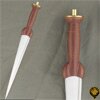 |
|
| Hanwei Scottish Dirk (SH2363) |
Points: 8
|
The ever-popular Early Dirk is strikingly authentic, its clean lines and carved hardwood hilt making it a clansman re-enactor favorite. Iberia Swords are crafted in much the same way as swords were made centuries ago, except that the blades are now forged from high-carbon spring steel, a resource unavailable off-the-shelf to the smiths of the old. The blade finish is far from being polished, again more closely replicating what the medieval swordsmith was able to achieve. Except as noted, grips are leather-covered hardwood. Fittings are either steel or solid brass. Except, where shown all of these swords have scabbards of leather-covered fiberglass with steel lockets and chapes and removable suspension rings. These swords will appeal to the re-enactor who wants a sword with the same appearance as the originals.
|
|
|
|
|
|
 |
|
| Hanwei Scottish Court Sword (SH1214) |
Points: 12

|
Quick and elegant describe the Scottish Court Sword. Replicating an original dating from the 1730's and belonging to an officer in Prince Charles Edward Stuart's army at Culloden, the finely chiseled silver-plated hilt and three-edged hollow ground blade exemplify the consummate skill of the swordsmiths of the period. See model SH2324 for the Practical Fencing Court Sword.
|
|
|
|
|
|
 |
|
| Hanwei Scottish Basket Hilt Backsword (SH2003) |
Points: 24
|
Early highland swords almost invariably carried the double-edged "broadsword" blade, but by the time of the Battle of Culloden (1746) the single-edged "backsword" was at least equal in popularity.Our Basket-Hilt Backsword, replicated from an original in the collection of the Royal Armouries in England that dates from about 1760, has an unusual basket with twin engraved "horned beastie" plaques and a blade with twin fullers running most of its length. The blade is German in origin, but the hilt and blade are contemporary.
|
|
|
|
|
|
 |
|
| Hanwei Trondheim Viking (SH2296) |
Points: 40

|
Hanwei continues to push the envelope with its forging capability in the Trondheim sword, produced as a one-piece forging in pattern-welded high-carbon steel. Patterned after swords that have been discovered in the area around Trodheim, Norway, the sword exhibits early ninth-century styling, a time when the Norwegian Vikings were pillaging Britain and Ireland. The beauty of the blade is matched by the grip and scabbard, both of which are wrapped in top-grain leather, engraved in a classic Viking motif.
|
|
|
|
|
|
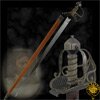 |
|
| Hanwei Cromwell Sword (SH1049) |
Points: 15

|
Oliver Cromwell (1599 - 1658) was a powerful figure in English history during and after the English Civil War, when he rose from the rank of Captain of Horse to Lord Protector of England. His sword, said to have been carried at the battle of Drogheda in 1649, has been remarkably well preserved and features in the collection of the Royal Armouries in Leeds, England, where it is displayed in the permanent collection. Our Cromwell Sword is an accurate replica of the original "mortuary" hilt style and features a blackened guard decorated in a gold foliage pattern with a wire-wound sharkskin grip. As the original sword now lacks a scabbard , we have provided a design typical of the period. This piece of English history is a must for the ECW collector and re-enactor.
|
|
|
|
|
|
 |
|
| Hanwei Side Sword (SH2203) |
Points: 14
|
The Side Sword was a military sword of the 16th and 17th century Renaissance period that also achieved popularity among civilians, due to its relatively light weight and quickness. It also had an advantage over its contemporary, the rapier, in having the ability to cut efficiently as well as thrust. Side swords were often the weapon of choice for sword and buckler fighting. Our side sword, based on a German original, is a beautifully proportioned piece that balances very well. The "swept" hilt affords excellent hand protection and the blade geometry makes for outstanding performance in both the cut and the thrust.
|
|
|
|
|
|
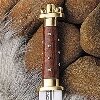 |
|
| Seax knife (401022) |
Points: 11

|
The seax, or sax, was universal in Northern Europe. Carried and used by the Saxons, Angles, Vikings and German tribes, its use probably dated before the fall of Rome and continued on into the early Middle Ages. From small knives with 3-4 inch blades to actual swords with blades of 27-28 inches and always single-edged, the profile of the seax varied a great deal. The original version of this large knife served from camp work to cutting work, on shipboard, and for fighting if a sword or axe was not available. The lobed pommel and guard are brass, and the wood grip is studded with brass tacks, for a very secure and comfortable grip. The blade is etched on both sides, flat ground, and capable of taking and holding a razor sharp edge. Leather sheath riveted and laced like the originals, has two thong slots. The remnants of this Seax can be seen in the British Museum. Made by Windlass Steelcrafts®.
|
|
|
|
|
|
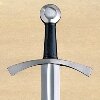 |
|
| Windlass Classic Medieval Sword (500020s) |
Points: 16

|
Sword is an Oakeshott Type X with a Type I pommel and a Type VII crossguard. The long and wide fuller on this blade lightens the overall sword and make it possible to deliver fast and shearing cuts, capable of cutting through the mail and padding that were worn during the period. The long guard offers good protection from an opponent's shield or blade, while the classic wheel pommel brings the sword very nicely into balance. This type of sword was in service for a long period of time throughout all of Europe. Made by Windlass Steelcrafts.
|
|
|
|
|
|
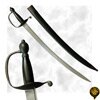 |
|
| Hanwei Revolutionary War Hanger (SH2375) |
Points: 13
|
Based on an original of the period, our Revolutionary War Hanger (or Cutte) is accurately sized and antiqued to replicate a museum piece. The fully tempered, blunt edged, high carbon steel blade has a distal taper, with fullers on both sides along the spine, and is light and quick. The hilt fittings are cast in solid steel, matching the locket and chape of the leather-covered scabbard.
|
|
|
|
|
|
 |
|
| Cheness Deluxe Carbon Steel Iaito (Iaito-1045) |
Points: 15


|
It is constructed in exactly the same way a carbon steel katana is... only blunted on the cutting edge. Hand forged, hand polished, full length nakago (tang), double mekugi (retaining pin). Perfect for those that want to practice kata using an iaito with the weight of a katana.
|
|
|
|
|
|
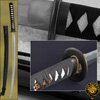 |
|
| Hanwei Practical Iaito |
Points: 12

|
Iaito have long been the preferred training tools for safe practice of the many Japanese sword drawing arts typically known as Iaido. While not designed for sword-on-sword contact or actual test cutting, the un-edged iaito is perfectly weighted and balanced for its designed task of safe, repetitive drawing practice.
Made of a special stainless steel, the blades are much more durable than iaito blades made from aluminum alloy, with a "live" feel and much superior rigidity. Through a special tempering process, these Iaito blades eliminate the brittle behaviour sometimes associated with stainless steel, while retaining its low maintenance and rust-resistant qualities. These very affordable Iaito are the ideal training tools for safely praciticing this ancient art.
White Same w/ Black Cotton Ito & Sageo
Etched Wave Tsuba, Fuchi & Kashira
Copper Menuki, Habaki, Seppa & Shitodome
|
|
|
|
|
|
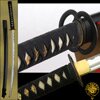 |
|
| Hanwei Musashi Iaito |
Points: 28
|
The Musashi Iaito provides an economical yet authentic sword for the Iaido practitioner. Available in 3 blade lengths (27, 28, 29) to perfectly match your needs. The blade is unedged for safety and forged from steel for more precise weight and balance than an aluminum blade can offer. The blade is also maintenance free, providing a lifetime of practice without worry of rust or tarnish. Miyamoto Musashi, arguably the most famous swordmaster in Japanese history, fought more than 60 duels before retiring and writing his famous treatise on swordplay, the "Book of Five Rings". Development of the two-sword style of swordplay, with the Daito (long sword) and Wakizashi being used together, is credited to Musashi. Mounted in black, the Musashi Elite is faithful to the original down to the famous double-ring iron tsubas. The tsuka-ito is in leather over ray skin.
|
|
|
|
|
|
|
|
Tags:
swords, sword, katana, wakizashi, tanto, japanese sword, medieval sword, viking sword, japanese swords, medieval swords, viking swords, knife, knives, saber, armour, movie swords, movie replicas, martial arts, sporting goods, sporting equipment,
|

















